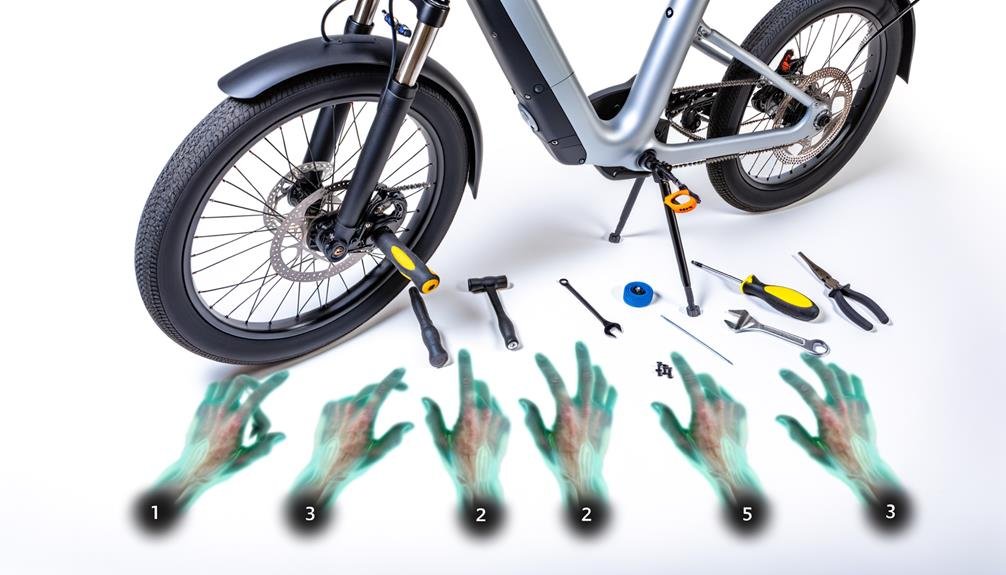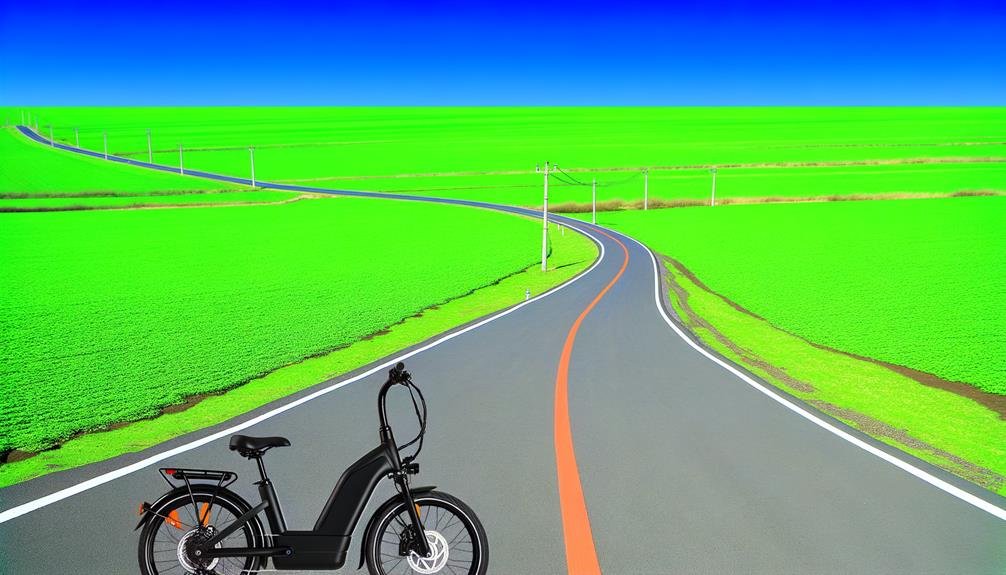Charles Miller is a veteran bike enthusiast with over 12 years of experience dealing with bikes as a mechanic. Despite immense love and expertise for...
Riding an electric bike is like merging the thrill of traditional cycling with the ease of a motorized scooter. We've found that the experience is quite different from riding a regular bicycle, as the electric assistance adds an interesting dynamic to the journey.
These bikes can reach higher speeds, and their various power delivery systems, such as torque-based sensors or cadence-based systems, offer a new dimension of control. However, it's not all smooth sailing – adjusting to the feel of these systems and the heavier weight of the bike can be a challenge.
Now you may wonder, how does one get used to these changes, and what should you be aware of when switching from a regular bike to an electric one? Stick around, we're about to unravel that for you.
- Key Takeaways
- Understanding Electric Bikes
- The Riding Experience
- Learning E-bike Controls
- Safety Measures on E-bikes
- E-Bikes Vs Traditional Bikes
- E-bike Battery Lifespan
- Essential E-bike Maintenance
- E-bike Rider Testimonials
- Pros and Cons of E-bikes
- Making the Switch to E-bikes
- Frequently Asked Questions
- Conclusion
Key Takeaways
- Electric bikes offer higher speeds and a more effortless ride compared to regular bikes.
- There are two main power delivery systems for electric bikes: torque-based sensors and cadence-based systems.
- Starting in a flat, open area and gradually increasing the assistance level helps in getting accustomed to the unique feel of an electric bike.
- Navigating traffic safely and following traffic rules and signals is crucial when riding an electric bike.
Understanding Electric Bikes
Diving into the world of electric bikes, it's crucial to understand that these bikes offer higher speeds than regular bikes owing to their motor assistance, transforming the way we perceive biking. The crux of understanding electric bikes lies in appreciating the technology behind them. Unlike conventional bikes, electric bikes, or e-bikes, utilize either torque-based or cadence-based power delivery systems.
Torque-based sensors provide a more natural, intuitive riding experience, mirroring the effort you put in. Contrastingly, cadence-based systems, although requiring some getting used to, offer a unique dynamic to the riding experience. Becoming familiar with this technologically advanced pedaling system is like learning a new biking language, adding a thrilling twist to the traditional biking narrative.
What is an electric bike like to ride, you ask? Well, we recommend starting in a flat, open area and gradually increasing the assistance level. This approach helps you get accustomed to the bike's power delivery.
However, it's not all about speed and power. Safety mustn't be overlooked. With the added weight of the motor and battery, braking requires extra caution. Identifying and adjusting to the type of brakes on your e-bike is a vital part of the learning curve.
In essence, riding electric bikes, or e-bikes, is an exciting journey of discovery and adaptation.
The Riding Experience
As we step into the world of electric bike riding, the initial ride feel is a paramount aspect to consider, as it varies greatly from traditional cycling due to enhanced speeds and distinct power delivery systems.
The impact of power assistance is another crucial topic, with factors like torque-based sensors and cadence-based systems playing significant roles.
The Initial Ride Feel
For first-time riders, the electric bike's initial ride feel offers a thrilling and unique biking experience. It is characterized by its higher speeds compared to regular bikes. When riding an electric bike, you'll notice different power delivery systems. These include torque-based sensors that provide a natural feeling and cadence-based systems that require some adjustment.
Initially, it's advisable to start in a flat, open area. Gradually increase the assistance level to familiarize yourself with the bike's unique feel. The experience is further influenced by the various assist modes and speeds available. These provide a balance between effort and ease.
The initial ride feel is undeniably exciting, offering a whole new dimension to biking that's different from a regular bike.
Power Assistance Impact
Undeniably, the power assistance feature of electric bikes dramatically transforms the riding experience, delivering higher speeds, quicker acceleration, and a more effortless ride compared to standard bikes.
The power assistance impact is most noticeable on arduous uphill climbs where the electric assist proves to be a game-changer. The motor provides a smooth, effortless boost, reducing strain on the rider.
Riders can adjust the level of assistance, allowing them to tailor their ride to their comfort and fitness level. Whether using a torque-based sensor for a more natural feel or a cadence-based system that requires a bit more adjustment, the power assistance of electric bikes offers a significant enhancement to the traditional biking experience.
We encourage riders to explore and embrace this transformative feature.
Navigating Traffic Safely
Navigating traffic safely is another crucial aspect of the electric bike riding experience that we must examine. When we ride an electric bike, we need to stay aware of our surroundings, especially the movements of cars. It's essential to follow traffic rules and signals as we traverse city streets.
Hand signals become our language to communicate intentions to other drivers. We've learned to maintain a safe distance from cars and always anticipate their next move to avoid collisions. Blind spots are our invisible enemies, so we always ride defensively, keeping safety at the forefront.
Ultimately, navigating traffic safely on an electric bike is about awareness, communication, and caution. With these strategies, we can enjoy our ride while ensuring our safety.
Learning E-bike Controls
Mastering the controls of an electric bike is a journey of discovery, where understanding the variance in power delivery systems, from torque-based sensors to cadence-based systems, can significantly enhance your riding experience. When we're learning e-bike controls, we're unlocking the potential of the electric motor, maximizing the joy and convenience that comes with riding an e-bike.
To make your learning process smoother, consider these key points:
- Start in a flat, open area and gradually increase the assistance level. It'll help you get accustomed to the controls.
- Grasp the brakes. Know which lever controls the front and rear brakes.
- Always be mindful of automotive traffic. Follow traffic rules and use hand signals to communicate your intentions.
- Choose the right gear according to the purpose and terrain of your ride.
- Understand the power delivery systems. Torque-based sensors give a natural feel while cadence-based systems provide consistent power.
Safety Measures on E-bikes
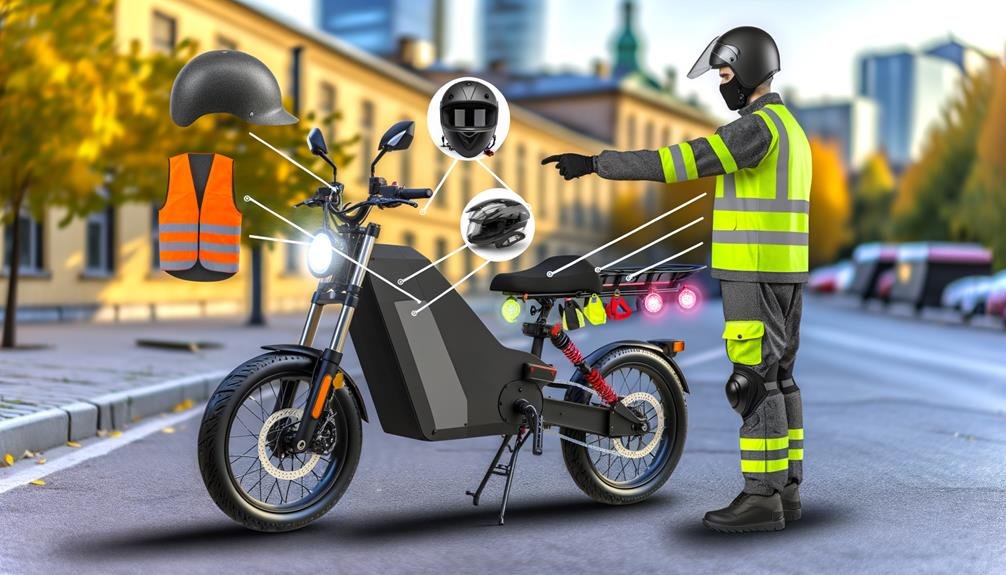
As we explore the realm of electric bike riding, it's essential we don't overlook the critical aspect of safety measures.
From the protective gear we wear to the pre-ride checks we perform, these steps ensure a secure and enjoyable e-bike experience.
Let's discuss how these elements play a vital role in our overall riding adventure.
E-bike Protective Gear
When it comes to ensuring safety while riding e-bikes, investing in protective gear is a vital step. We're here to guide you through the essential items you should consider to ensure a secure and enjoyable electric bike experience.
- A helmet is non-negotiable. It's your number one defense in case of accidents.
- Reflective clothing increases your visibility, especially useful when riding in low light conditions.
- Knee and elbow pads might seem excessive, but they provide extra protection.
- Gloves not only protect your hands but also improve your grip on the handlebars.
- Lastly, protective eyewear shields your eyes from debris and wind.
We're all part of the e-bike community, let's prioritize safety as we enjoy the freedom and excitement of the electric bike revolution.
Pre-ride Safety Checks
Building on the importance of protective gear, it's equally crucial to conduct pre-ride safety checks to ensure the optimal performance of your e-bike and further enhance your safety.
Just as with regular bikes, these checks involve key steps. Firstly, we must verify our e-bike's battery is fully charged and tires are properly inflated. Next, we inspect our bike for any damages or malfunctions. We test the brakes, lights, and signals for functionality.
Safety gear, like a helmet and reflective clothing, is vital, especially for nighttime e-bike rides. Lastly, we adjust the seat ensuring comfort and safety.
Conducting these pre-ride safety checks sharpens our sense of belonging while riding e-bikes, cultivating a safer and more enjoyable experience for all.
E-Bikes Vs Traditional Bikes
Delving into the comparison between e-bikes and traditional bikes, it's crucial to note that e-bikes, with their higher speeds and unique power delivery systems, provide a different riding experience that requires a bit of adjustment, especially in terms of braking and navigating automotive traffic.
When comparing e-bikes vs traditional bikes, there are several key differences to highlight.
- E-bikes offer higher speeds than regular, non-electric bikes. This means we can get to our destination faster, but it also means we need to be more aware of our surroundings.
- The power delivery systems on e-bikes, such as torque-based sensors and cadence-based systems, differ from those on traditional bikes. These systems require some getting used to.
- Braking on an e-bike requires a bit more care due to the bike's heavier weight.
- Navigating through automotive traffic on an e-bike can be tricky due to the bike's higher speed and different handling characteristics.
- Lastly, electric bikes require a bit more maintenance, including battery charging and more frequent inspections.
E-bike Battery Lifespan

As we move on to the topic of e-bike battery lifespan, it's crucial to understand that maximizing battery performance is a combination of correct usage and maintenance. Various factors can cause battery degradation, such as deep discharges and prolonged periods of low charge.
Maximizing Battery Performance
To ensure the longevity and optimal performance of our e-bike's battery, it's crucial to fully charge it before each use. This not only increases the number of miles per ride, but also contributes to maximizing battery performance over time.
Here are some tips to help us get the most out of our e-bike's battery:
- Always charge before use, never let the battery fully drain.
- Store in a cool, dry place when not in use.
- Regularly check and clean battery connections.
- Use the manufacturer-provided charger to avoid overcharging.
- Avoid exposing the battery to extreme temperatures.
Understanding Battery Degradation
While we've just explored ways to maximize our e-bike's battery performance, it's equally vital for us to grasp the concept of battery degradation and understand its impact on the lifespan of our e-bike batteries. Battery degradation is an inevitable part of riding one of the best electric bikes, but understanding what causes it helps us manage it better.
Factors like usage, charging habits, and environmental conditions play significant roles in battery degradation. Here's a quick overview:
| Factor | Effect on Battery |
|---|---|
| Usage | High usage accelerates degradation |
| Charging Habits | Irregular charging can shorten lifespan |
| Environment | Extreme temperatures hasten degradation |
Proper storage and maintenance, coupled with regular monitoring, allow us to maximize our e-bike's battery lifespan.
Essential E-bike Maintenance
Let's delve into the crucial aspect of essential e-bike maintenance, which involves regular tire pressure checks, optimal battery charging, routine cleaning, component inspection, and secure storage to ensure the bike's optimal performance, safety, and longevity. As part of the riding community, we understand the importance of keeping our bikes in top shape, not just for a stellar riding experience but also for our safety.
- Regularly check and inflate the tires to the recommended pressure. This helps prevent wear and tear, ensuring a smoother ride.
- The heart of an e-bike, the motor or battery, requires careful monitoring. Keep it charged but avoid overcharging or deep discharging to prolong its lifespan.
- Cleanliness isn't just about aesthetics. Regular cleaning and chain lubrication prevent rust and ensure smooth operation.
- Regularly inspect the brakes, gears, and other components. Early detection of wear or damage can save you from potential accidents and hefty repair costs.
- Finally, store your e-bike in a dry, secure location. This simple practice prevents theft and protects your bike from harmful weather conditions.
In essence, our e-bike is more than just a ride; it's a companion that requires care and attention.
E-bike Rider Testimonials
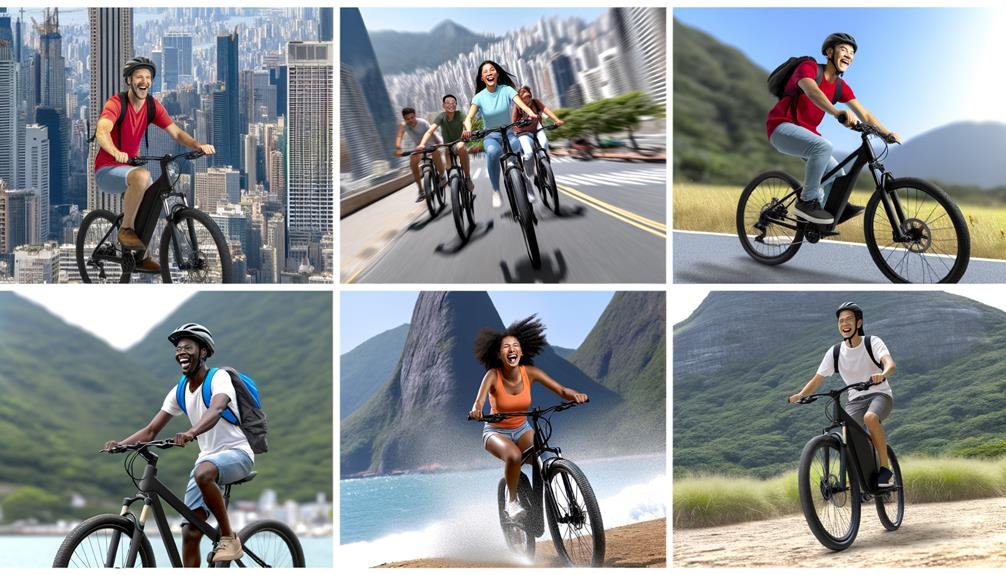
Having covered the vital aspects of maintaining our e-bikes, we now turn our attention to the real-life experiences of riders who've embraced this innovative mode of transportation. E-bike riders have shared their testimonials, giving us valuable insight into what is an electric bike like to ride.
| E-bike Rider Testimonials | Rider's Experiences |
|---|---|
| 'Feels like having a constant tailwind' | The ride is effortless and enjoyable, a sensation akin to a constant tailwind. |
| 'Torque-based sensor provides a smooth ride' | The sensor makes adapting to different terrains easy, providing a smooth, natural riding experience. |
| 'Pedal assist feature enhances comfort' | The customizable level of assistance is akin to riding a regular bike, offering comfort and ease. |
| 'Higher speeds and power systems offer thrill' | The thrilling and liberating experience comes from the bike's high speeds and power delivery systems. |
| 'Navigating through traffic feels safe' | E-bike riders find commuting stress-free and efficient, offering a safer navigation through traffic. |
These e-bike rider testimonials clearly illustrate the benefits of this progressive mode of transportation. From effortless rides to safe navigation through traffic, it's evident that e-bikes provide a unique, satisfying experience.
Pros and Cons of E-bikes
So, what exactly are the pros and cons of e-bikes?
Starting with the pros, we've found that:
- E-bikes offer a speedier and less strenuous ride, making commuting less of a chore.
- They break down barriers of distance and stamina, allowing us to venture further and faster.
- They're a greener choice, helping us reduce our carbon footprint.
- Despite being motorized, they still provide a dose of physical exercise and fresh air.
- The sleek design and user-friendly display panel enhance the overall riding experience.
However, like anything, e-bikes have their downsides:
- Assembly can be a two-person job, and you'll need a bike pump for the tires.
- The market is flooded with cheaper e-bikes, but beware of compromising quality.
- Your e-bike might become too popular among your friends, leading to frequent borrowing requests.
- The heavy bike can make unassisted pedaling a challenge.
- Different levels of assistance across e-bikes might require an adjustment period.
In short, knowing what's an electric bike like to ride means understanding the pros and cons of e-bikes. We hope this helps you make an informed decision.
Making the Switch to E-bikes
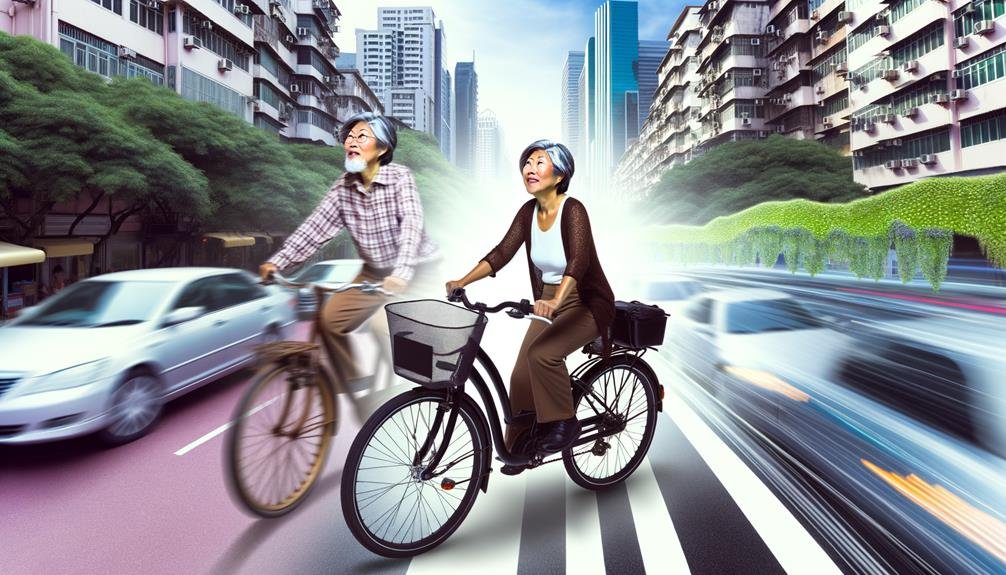
After weighing the pros and cons of e-bikes, you might be considering a switch to this high-tech mode of transportation. Making the switch to e-bikes involves more than just hopping on and pedalling away. It's a different riding experience, with higher speeds and a unique power delivery system. When you ask, 'what is an electric bike like to ride?', remember, it's essential to grasp the differences between torque-based and cadence-based sensors for a more natural ride.
Start in a flat, open area, with the assistance level at its lowest setting. Gradually increase as you grow comfortable. Be mindful around cars. Automotive traffic poses significant risks for e-bike riders, and being aware of cars and their movements is crucial.
Consider, too, the purpose and terrain for your e-bike rides. There are various types of e-bikes available: road, gravel, commuting, and folding bikes. Each offers a unique ride. The key is to find the one that aligns with your needs and environment.
In essence, making the switch to e-bikes is an exciting plunge into a new world of cycling, offering an enriched and efficient riding experience.
Frequently Asked Questions
Is It Hard to Ride an Electric Bike?
We've found riding an electric bike isn't hard. It boosts pedaling efficiency, extends battery lifespan with smart use, and ensures safety. With proper measures, we're confident you'll feel a sense of belonging in the e-bike community.
Are Electric Bikes Comfortable to Ride?
We've found electric bikes extremely comfortable to ride! They offer saddle comfort, minimize posture impact, and ensure ride smoothness. You'll feel a sense of belonging on the road, effortlessly tackling hills and long distances.
Can You Ride an Electric Bike Like a Normal Bike?
We can ride an electric bike like a normal one, but with added benefits. Battery longevity enhances rides, maintenance is manageable, and they're adaptable to various terrains, making the experience both exciting and convenient.
How Does an Electric Bike Feel?
We've found riding an electric bike exhilarating. The pedal assistance impact boosts our speed while the battery lifespan keeps us going. Despite the e-bike's speed, we've felt a sense of belonging within the cycling community.
Conclusion
In conclusion, riding an e-bike is like soaring on a magic carpet, effortlessly gliding over hills and speeding past traffic. They're not just bikes, they're game-changers, giving us the freedom to conquer any terrain with ease.
But remember, with great power comes great responsibility. Careful handling, regular maintenance and safety measures are paramount.
E-bikes aren't merely a fad; they're the future of sustainable commuting, promising an exhilarating, eco-friendly ride with every pedal stroke.

Charles Miller is a veteran bike enthusiast with over 12 years of experience dealing with bikes as a mechanic. Despite immense love and expertise for his Tacoma, he rides his Trek Ebike more. Anytime you meet him, you’ll either hear him talking about Bikes, or writing about all things bikes and cars on this blog.
More Posts
